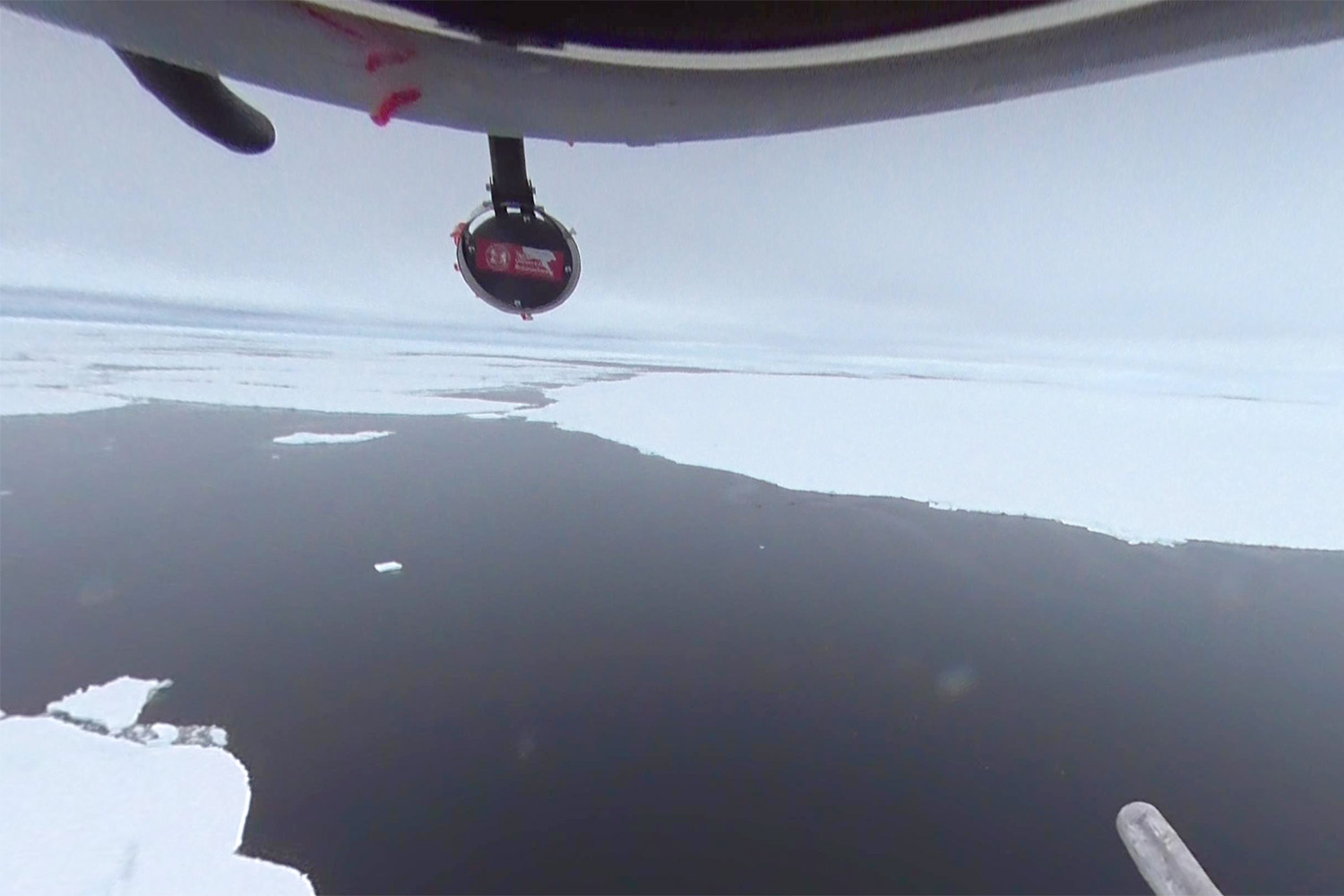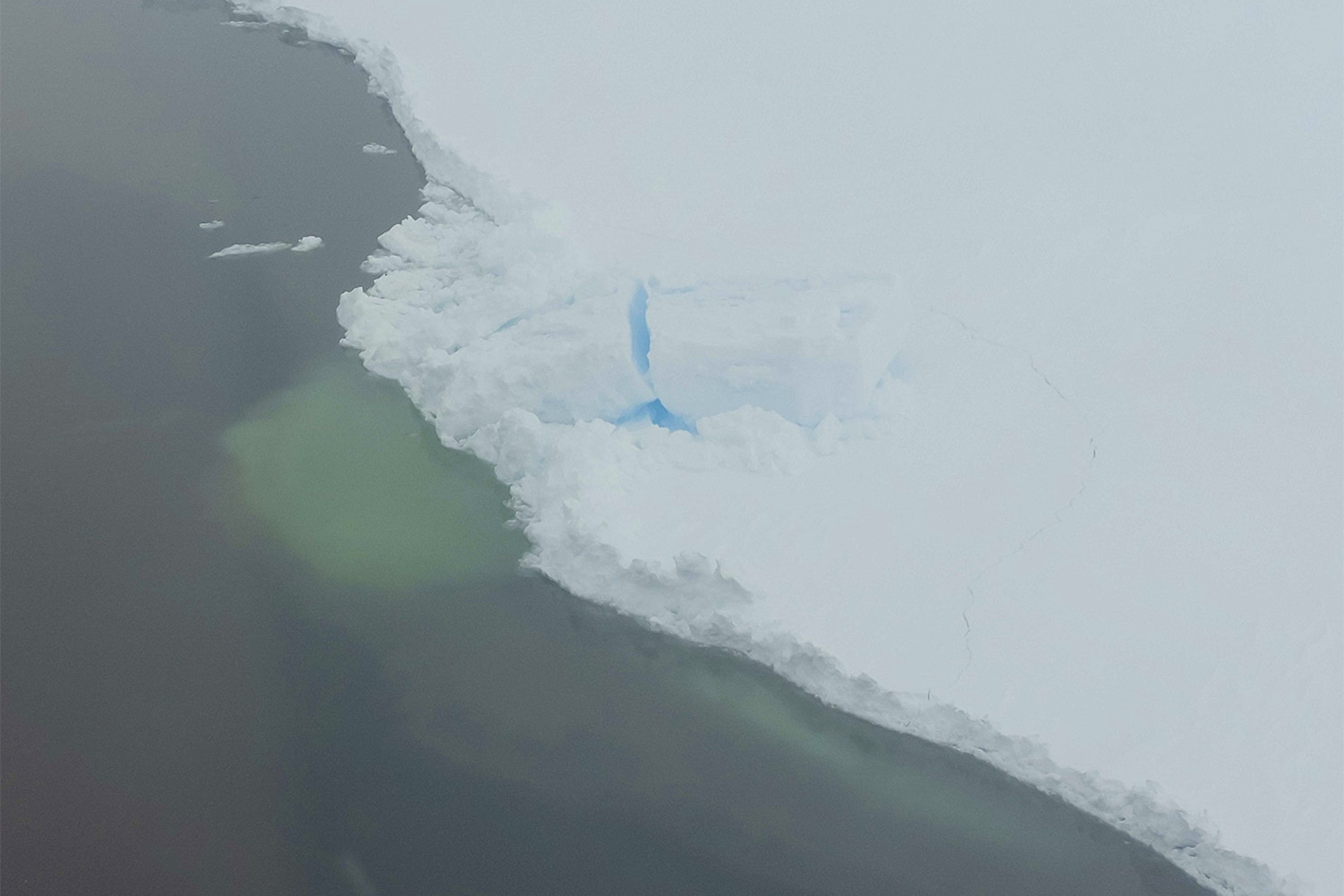Mail from the ice (3) Magnus Asmussen and Dr.-Ing. Falk Pätzold report from Arctic expedition
In May 2023, the research vessel “Oden” set off for the Arctic. On the Swedish expedition “ARTofMELT” (7 May to 15 June), the researchers observe weather, air and water. They want to find out why and when the ice begins to melt and which processes are important for melting. Two scientists from Technische Universität Braunschweig also went on board. Their emails give us a small insight into their work and everyday life during their research trip. The collected measurement data can be used to investigate which processes have which influence. The data is also used to test and improve models.
All episodes: Mail from the ice (1) | Mail from the ice (2) | Mail from the ice (3)

A picture of the research environment of the ARTofMELT expedition, captured by the HELiPOD. Photo credit: IFF/TU Braunschweig
From: Falk Sent: 05.06.2023, 21:42 Subject: It's making itself scarce and swarming
At temperatures around -3 to -5 °C, it is impossible to think of flying because of the danger of icing. Work on the floe is restricted due to sometimes low visibility and therefore difficulty in spotting polar bears in time.
Yes, and they are swarming everywhere, relatively speaking. Yesterday morning, two adult specimens of them met barely a kilometre away and exchanged information. The “exchange” looked quite robust, but was not characterised by flying claws. Tonight’s polar bear took an interest in equipment on the ice, but only very tentatively nibbled at the insulation of a crate. This afternoon, a mother polar bear and her offspring came within phone-camera range of the ship. Later, on their foray across the science-occupied floe, they knocked over an instrument, not without first measuring the albedo of the polar bear cubs. These encounters with the kings of the Arctic are always surrounded by a fascination that is hard to describe.
Furthermore, the Fram Strait is now “swarmed” with research icebreakers! According to AIS, the Polarstern is about 30 NM to the east, the Kronpris Haakon about 70 NM to the southwest.
And then there is a swarm of floes that want to break the floe that has already been picked out by science here. This fragmentation of the floes is a completely natural process in which the smaller floes are very quickly pulverised between the larger ones. After certain defragmentations, “our” floe is no longer the largest. The current plan is for the Oden to drift with this floe until the end of the expedition and then return to Longyearbyen on 14 June.
From: Falk Sent: 08.06.2023, 21:00 Subject: Quietly trickling ice crystals
Very fine ice crystals trickle out of the low-hanging grey out there and the air is so low in aerosols that your breath doesn’t condense. The aerosol fraction on board is very satisfied right now. However, the HELiPOD fraction was not satisfied. Shortly after take-off, nothing was reported in the WebApp. So the flight was aborted. We got the “Go!” from the flight director for a second attempt and restarted the measuring equipment. At first everything looked great, but after the first climb to 6000 ft the measurement bus-based data showed failures. Follow-up: error found on measurement bus cable. The list of details to be improved on the HELiPOD has lengthened accordingly, my mood has recovered.
But my mood is not really recovering with regard to the electronic helpers surrounding us. If at home it is a source of constant resentment that things can’t somehow be done online, here we see the flip side: the various software products react with varying degrees of grumpiness/pushiness/sniffiness to the lack of access to this internet. Windows 11 seems to be even more preoccupied with itself than usual, my smartwatch doesn’t want to talk to the associated software on my phone without a network, Spotify stopped its service.
But hej, and this greeting goes out to all programmers: Certainly there are technical reasons, and legal and financial reasons, why things work the way they do. And certainly a few fringe members of society on the edge of the northern ice sheet are not a target group. But please, a little more mercy would seriously ease the work here and in similar places cut off from the fibre optic network.

Green haze instead of shimmering blue ice. Photo credit: IFF/TU Braunschweig
From: Falk Sent: 10.06.2023, 17:06 Subject: Fog report
The binoculars on the bridge are not really getting any attention today, because it’s foggy out there, 50 to 100 m visibility. This means that activities with the helicopter are cancelled, as well as work on the ice, because the polar bears roam around even in this weather and are quite well camouflaged.
In fact, they are here in the flesh every day, and not just their footprints on many of the floes. On yesterday’s 12th helipod flight too, we flew over one of them at the south-easternmost point of the flight path, then later two large dark whales as well. Busy with all kinds of typing on the computer, I was just able to catch them for a second thanks to a remark from the helicopter pilot.
Among other things, we measured the carbon dioxide distribution. The strong increase in concentration with increasing altitude is typical for the northern hemisphere at this time of year, because the growing season is just beginning and at the same time the Arctic Ocean is a strong CO2 sink. This sink effect is due, among other things, to the myriads of micro-organisms that colour the ice, which otherwise shimmers blue under water, with a green haze.
From: Magnus Sent: 11.06.2023, 14:06
Since we moored at the ice floe, the work has become much more intense. In addition to a shift change in the work on the bridge, we spent quite a bit of time on the ice. The main activities were lowering a probe to a depth of 500 m to determine salt and heat flows in the water column, and constant evacuations to avoid polar bears, sometimes several times in one day.
These polar bears are becoming more and more common. We must have seen about 28 adults by now. Most of them come at night and are scared away by the ship’s horns or, in more tenacious cases, by flare guns. However, as they like to appear at night, the sound of horns and gunshots often wakes you from your sleep. But by now you have gotten used to it.
On Tuesday we have another Fancy Dinner, the finals of the table tennis tournament are also taking place, and on Wednesday evening we arrive in Spitsbergen in order to have solid ground under our feet again on the morning of 15 June after a successful berth check. Personally, I am very excited to have a non-moving floor with constant engine or generator vibrations.
Then it’s off to Oslo, where there will probably be another bar evening together, and on 16 June Falk and I land at BER. What is the strike situation like there at the moment? 😀
Besides all the organisational preparations for the journey home, there are more and more conversations about visits, reunions and how sad it is that the time is passing. A little melancholy is increasingly present in many conversations. Another constant topic of conversation is whether people will have a holiday after the trip or whether they will go straight back to work. Most seem to want/need to throw themselves straight into the evaluation. Some plan to have a few days off.
All episodes: Mail from the ice (1) | Mail from the ice (2) | Mail from the ice (3)
